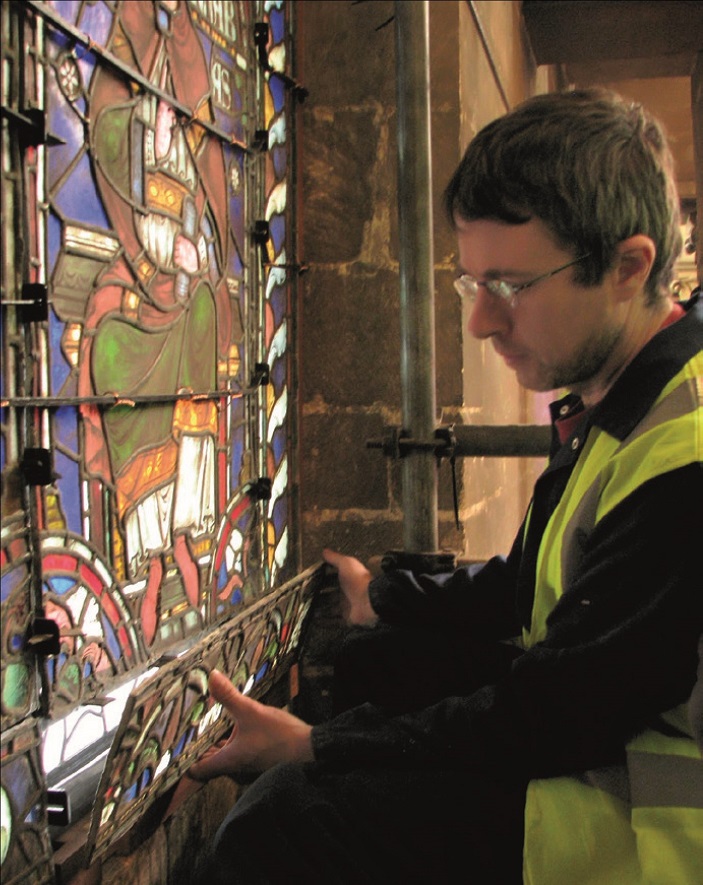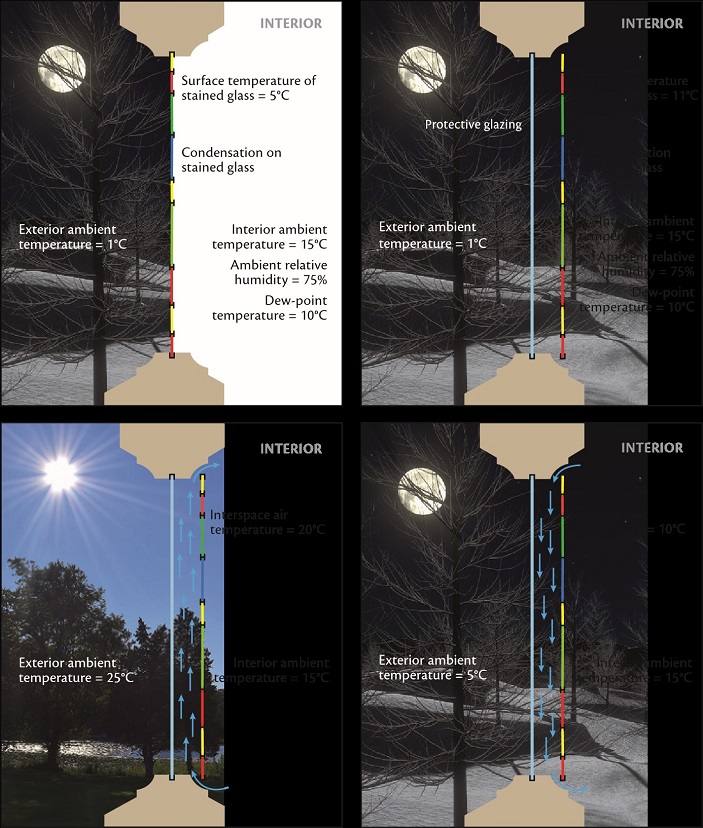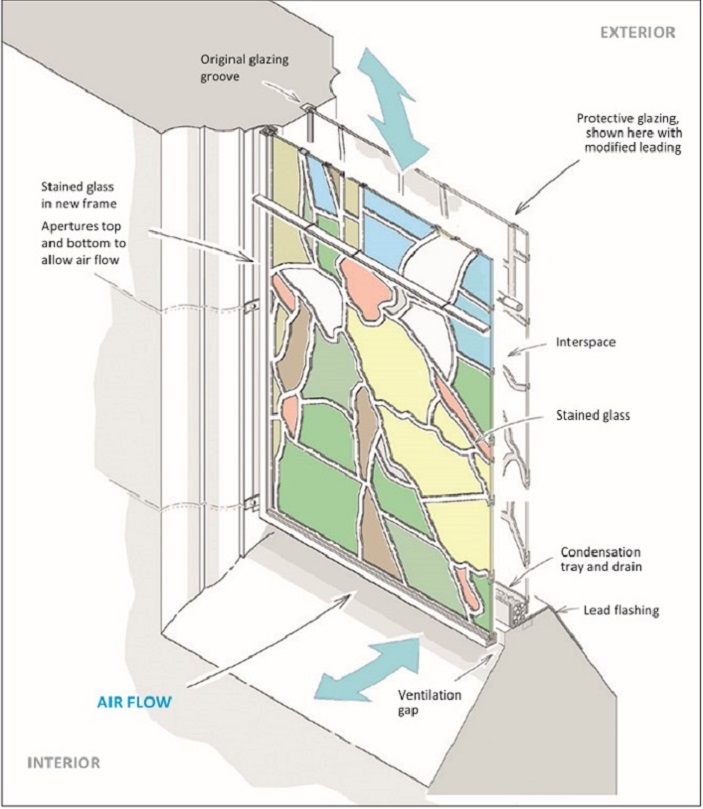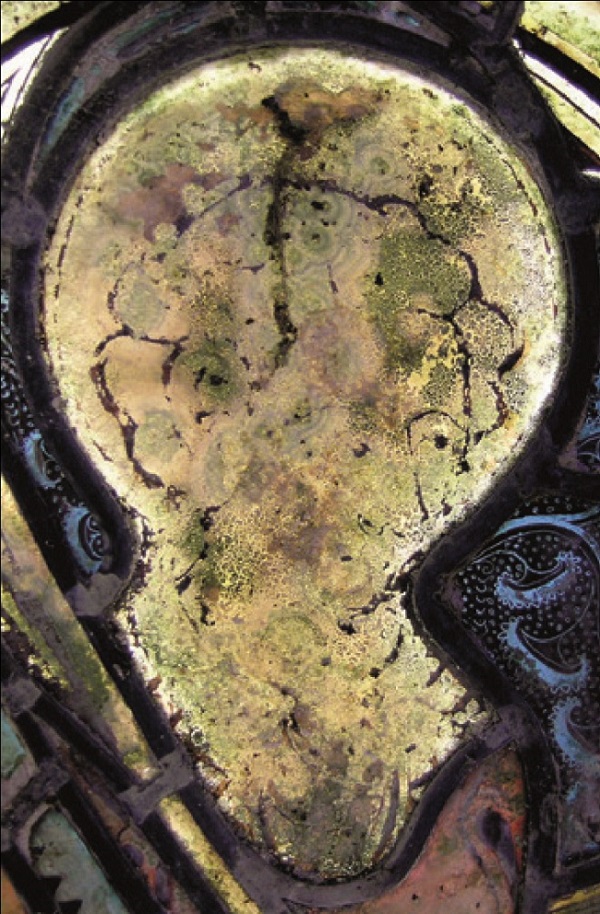Protective Glazing
Deciding Whether or Not to Use EPG
Robyn Pender
 |
||
| David Griffiths installing the modified stained glass into an EPG scheme at Canterbury Cathedral. (Photo: Leonie Seliger) |
Environmental protective glazing (EPG) systems are increasingly being used to protect our most important and most vulnerable stained glass windows from decay. If well executed these systems can provide the protection required to enable fragile examples to be retained in situ. On the other hand, they can be challenging interventions, entailing alterations that can harm the character and historic significance of the windows. To be sure that EPG is the right solution, and if so that it is optimally detailed, a wide range of contributory factors need to be taken into consideration.
THE NEED FOR EPG
Stained glass windows are not just beautiful works of art: for a millennium they have been a favoured way of decorating important buildings, especially churches and cathedrals, and so are of the greatest historic significance. Windows are also part of the building envelope separating the interior from the exterior, and indeed are its most fragile and least massive component. This makes stained glass particularly vulnerable to environmental deterioration. Well executed glazing with well-made glass and well-fired paint may nevertheless survive centuries in almost perfect condition; but if it is technically flawed (for example, if the glass is chemically unstable or the painted decoration incorrectly applied or insufficiently fired) then environmental deterioration can be serious. Problems include:
• glass corrosion, loss of painted decoration, and growth of algae and other micro-organisms due to condensation, and in some cases rainwater
• corrosion of metal supports, including the rusting of ferramenta, with the consequent cracking and loss of stonework
• wind pressure causing distortion and collapse
• projectile damage (both deliberate and accidental).
For stained glass windows suffering from serious environmental problems, there are very few options that allow them to be safely preserved in situ over the long term. Since the drop in the price of glass in the 19th century, one treatment has been to place a second glazing plane on the weather side of the window.
Early experiments along these lines were fraught with problems including interstitial condensation and algal growth, but ventilating the space between the glazing planes was found to greatly improve results, and is now an essential feature of modern ‘environmental protective glazing’ (EPG).
Despite research, the functional criteria for ventilating EPG were not well understood. Air flow was clearly critical, but how wide apart did the glazing planes need to be, and how much of a barrier to flow were elements in the interspace such as ferramenta? How should the interspace be ventilated? Ventilation towards the interior ensured the stained glass was embedded in the warmer internal air of the building, but would ventilation to the exterior work as well?
To answer these and other technical questions, in 2014 Historic England commissioned a research project centred on in situ and laboratory testing, and the assessment of a wide range of existing EPG installations. The project was led by Tobit Curteis of Tobit Curteis Associates and Leonie Seliger of The Cathedral Studios, Canterbury, with contributions from specialists in microbial growth and in modelling air flow. The report on this research has now been released, together with a guidance note that puts EPG in the wider context of environmental deterioration of stained glass.
TECHNICAL CONSIDERATIONS FOR EPG
 |
||
| Schematic diagrams showing how EPG works against condensation: the direction of airflow will be dynamic, changing continually throughout the day and night in response to the exterior conditions. (Diagram: Historic England/Robyn Pender) |
The research confirmed that the key to successful EPG is the ventilation of the interspace between the two panes of glass at the top and the bottom of the window. If the building fabric is in good condition, with no serious moisture problems to increase the interior relative humidity, properly ventilated EPG prevents almost all instances of condensation on the stained glass. Even in poor conditions, condensation events are much reduced.
The airflow is driven by the difference between the buoyancy of the air in the gap between the glazing planes (the interspace), and the buoyancy of the air in the space to which the gap is being vented. Buoyancy is primarily driven by air temperature, and to a lesser extent by relative humidity: hotter air and more humid air will both rise. Because glass is very sensitive to ambient temperature changes, the natural heating and cooling of the exposed exterior protective glazing will condition the air in the interspace. Solar gain and changes in air temperature produces remarkably strong vertical airflows, the direction of which will change according to the relative temperatures of the interior and exterior air.
Flow is easily strong enough to overcome pinch-points such as ferramenta in the interspace. The minimum depth should generally be no less than 40mm, but as long as there is a minimum of 10mm gap at any pinch-points, the air flow can overcome any problems of turbulence. It is, of course, best to minimise obstructions as much as possible.
Although the necessary depth can often be achieved with the stained glass left in its original glazing groove, in some cases it would need to be framed and moved slightly forward in the window splay.
Ventilation was found to be most effective when the gaps at the top and bottom ran across the entire width of the glazing; but even smaller or less even vents can still produce acceptable flow, especially in tall windows. For maximum effect, the vent height should be at least one-third of the interspace depth: in other words, if the interspace depth is 60mm, the vents would need to be at least 20mm high.
Wherever possible the ventilation should be towards the building interior (through the stained glass); but in instances where that cannot be achieved (whether because of the configuration of the window, or perhaps the fragility of the glass, or some other reason) we found that ventilating towards the exterior, through the protective glazing, will still give a marked reduction in condensation events. It is important to caution, however, that exterior-ventilated EPG will be at much greater risk of rainwater penetration.
Condensation may be reduced or prevented on the stained glass, but it will still occur on the secondary glazing; and there will always be some risk of rainwater penetration as well. Therefore the interspace will need to incorporate some means of collecting any liquid water, and usually way of removing it from the interspace. The most effective method is to place a lead-lined collection channel at the base of the window, with drainage out to the exterior (through the secondary glazing). This channel should be filled with graded gravel, which will greatly reduce any evaporation of the collected water back into the interspace, as well as cutting air ingress into the interspace from the exterior.
 |
||
| Cut-away diagram of a typical EPG system with the original stained glass brought inwards and a new leaded light in the original glazing location. (Diagram: Historic England/Iain McCaig) |
It is important to design EPG to allow for good maintenance. It should give easy access to the interspace to allow for cleaning and clearance of the drainage. For important stained glass, an advantage of framing stained glass may be quick dismounting in an emergency, but the fixtures and fittings must be chosen with care to ensure this does not increase the risk of theft. (This system was put to the test once at Canterbury Cathedral when the stonework of the Great South Window failed suddenly and catastrophically, and the stained glass was saved.)
PROS AND CONS OF EPG
By protecting the stained glass from direct weather impacts, and in particular from ultraviolet light (the exterior glass can be chosen to reduce UV penetration) EPG can help stained glass conservators avoid extensive repair, giving them the opportunity to use more sensitive and reversible materials such as epoxy glues to repair glass which would not be suitable if the stained glass needed to act as a weather barrier. Indeed, EPG may sometimes be the only way to preserve in situ a window made with highly light-sensitive or water-sensitive materials (such as fibreglass). In some circumstances, it can also help prevent impact damage; and it is largely reversible.
On the other hand, EPG can also be one of the trickiest interventions to manage, principally because of its impacts on the wider building. The precise look of the single sheet of stained glass in its original position in a window is critical to the aesthetics of the building, both on the interior and the exterior, and it will have been considered with great care by the original architects and glaziers. The nature of EPG means it will also usually require a small degree of permanent change to the fabric (for example, new glazing grooves cut into the stone surrounds, or moving of the metal supports).
These impacts can be mitigated but doing so successfully requires all stakeholders to consider a wide range of options before agreeing on the best approach. The aim must be to arrive at an agreed view on the significance of the window, and the contribution it makes to the significance of the building; and on how these might both be sustained and enhanced. Together with technical requirements, this means that optimum design for EPG may well vary from window to window, even on the same building. This is eloquently illustrated in a case study by Dan Humphries.
There are other risks as well. Single stained glass windows allow a low level of natural ventilation, and this can be very important for the condition of the building: increasing air tightness with EPG may therefore have unintended consequences. There is also a risk that, in diverting condensation away from the stained glass, it may increase condensation events elsewhere (notably on the ferramenta).
DECIDING WHETHER OR NOT TO USE EPG
As with all good practical conservation, EPG is not an intervention that would be used on stained glass in good condition ‘just in case’. It may be the right solution if:
• despite building repairs and adjustments to the climatecontrol systems, environmental problems continue to have serious impacts on the window; or
• the stained glass is very fragile and/ or historically important, and will be compromised technically or aesthetically by repair methods that would render it watertight and wind-resistant; or
• the technique of the stained glass renders it particularly susceptible to condensation damage (underfired Victorian glass is a notable example); or
• the stained glass is so significant that no further loss, however slight, is acceptable; or
• there are good conservation reasons to avoid dismantling the window for repair (such as the risk of damage, or the wish to retain early and important leading); or
• the window is very inaccessible (and unusually difficult to inspect and maintain).
 |
||
| Microbial growth on medieval stained glass rendering its original image completely illegible. (Photo: Leonie Seliger) |
It is sensible to undertake an options appraisal that considers all the potential impacts (good and bad) in some detail before deciding whether EPG is the correct intervention for delivering the aims of a stained glass conservation project. This appraisal will need to include:
• the significance of every component that might be affected by EPG (the glass, the lead net, the stonework and the ferramenta)
• the contribution made by each component to the viewer’s aesthetic appreciation of the window
(from both the interior and the exterior)
• the condition of all those components, and the nature and rate of their deterioration
• the potential positions of the two glazing planes within the depth of the window embrasure. What possibilities are afforded by the profile of the embrasure, and what would be the aesthetic impact of the glazing planes on the window, considered in the context of the building as a whole?
• how the windows (including those where it is not proposed to use EPG) contribute to the building’s architectural design, historic interest and aesthetic character.
Aesthetic success will depend largely on the design and materials of the protective glazing. Well-designed EPG can and should be all but invisible, even to a knowledgeable viewer. The new Historic England guidance note gives extensive guidance on this aspect of EPG.
The primary contributor to designing effective and sympathetic EPG will be the stained glass conservator, who should have ample experience adopting EPG to suit many different situations. They will need to work closely with the stakeholders, and perhaps with other specialists such as stone conservators and metal conservators. In difficult cases, it might be necessary to speak with a building performance expert, who can suggest ways of assessing the in situ conditions, and the effectiveness of the EPG design.
Sensitive design will greatly reduce the impact on the building, but since EPG should only be used where there is a demonstrable need for it, design should never trump the effectiveness of the system. If EPG is required, then the principal design criterion must be that it can do the job being asked of it.
Further Reading
T Curteis and L Seliger for Historic England Research Report, Conserving Stained Glass Using Environmental Protective Glazing, London, 2019
Historic England Guidance Note, Stained Glass Windows: Managing Environmental Deterioration, Historic England, Swindon, 2019
English Heritage, Glass & Glazing: Practical Building Conservation Series, Routledge, London, 2011
English Heritage, Building Environment: Practical Building Conservation Series, Routledge, London, 2014



